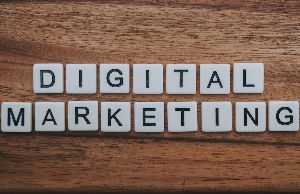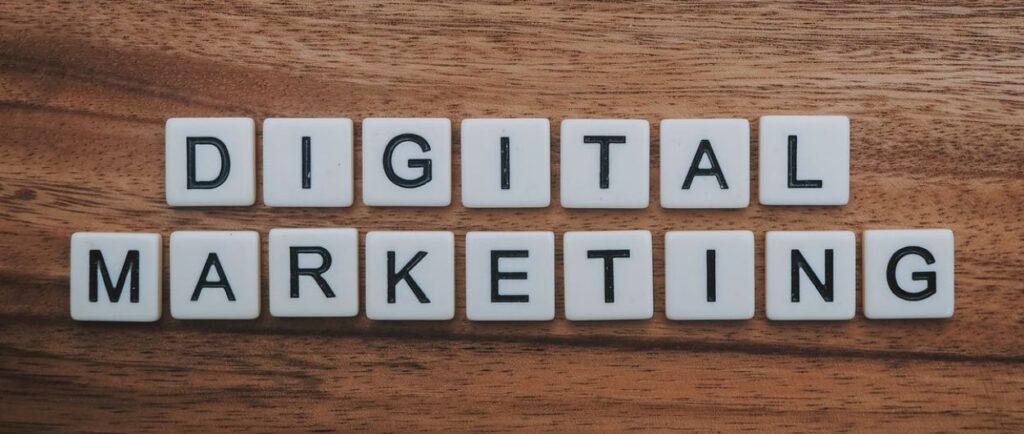
Digital marketing funnels are the backbone of any digital marketing campaign. A marketing funnel is a process that marketers use to attract and convert prospects into customers. It is a visual representation of the customer journey from top to bottom. The goal is to maximize the number of leads at the top and minimize those at the bottom.
It is a step-by-step process, and the journey from building an audience to converting them into leads or customers is mapped out systematically. But, of course, it goes without saying that it takes time and effort to implement.
The digital marketing funnel is a framework that can be used to plan, manage, and measure the success of a digital marketing campaign. Generally, it starts with the acquisition of new customers, followed by the conversion of those customers into leads, then finally converting those leads into paying customers.
It is a four-step process that marketers use to guide prospects from becoming aware of their product or service to make a purchase. The four steps are Awareness, Interest, Desire, and Action.
This is all a part of the traditional marketing setup. But as times have changed, digital marketing has increasingly become an integral part of the business. And digital marketing works a bit differently as compared to the traditional marketing setup.
That is why the digital marketing funnel involves modern methods of marketing. Though the goal of the former is similar to the latter, the digital marketing funnel is more expansive, covers all the modern marketing strategies and steps of online buying.
What is the major difference between Traditional Marketing Funnel and Digital Marketing Funnel?
As businesses evolved due to technical advancements, the evolution of the digital marketing funnel was inevitable. The number of internet users crossed 4.9 billion in 2021, which accounts for over 63% of the global population.
Furthermore, the number of smartphone users has risen dramatically. In 2020, smartphone users were responsible for over 50% of internet traffic. Google, YouTube, Facebook, and Amazon were among the highest visited sights.
As a result of the developments mentioned above, customers have access to an immense amount of information. It has naturally brought a drastic change in the way they buy things. That is why modern shopping is a custom, non-linear experience.
Now, with so many changes at play, the traditional marketing model is hardly suitable or sufficient for modern businesses. It tends to miss out on critical opportunities to reach out to the customers where they are. Here are some basic differences between traditional and modern digital marketing funnels.
- The traditional marketing funnel begins with awareness and ends with the sale. The digital marketing funnel begins with awareness and ends to return to awareness.
- The traditional marketing funnel is linear, which means they start at the top of the funnel, go through each stage, and end at the bottom of the funnel. The digital marketing funnel loops back and forth between stages in order to optimize conversions.
- The traditional marketing funnel is the process of attracting customers, generating leads, converting leads to sales, and then retaining customers. The digital marketing funnel is a more complex process that includes tracking who has visited your website, measuring the effectiveness of your digital marketing efforts, and determining which channels are most effective for your business.
- The traditional marketing funnel includes four steps: awareness, consideration, decision, and purchase. While this article will discuss the different types of digital marketing funnels, the ‘hourglass’ digital marketing funnel consists of up to 10 steps.
- The digital marketing funnel is different from the traditional marketing funnel because it includes the use of social media platforms, email campaigns, and other online channels to engage potential clients.
What is the main purpose of A Digital Marketing Funnel Serve?
The digital marketing funnel has been around for quite some time now, and it has become an important element in digital marketing strategy.
The idea behind this model is to help marketers identify and target potential customers more efficiently by dividing them into groups based on their level of engagement with your content.
The goal of a digital marketing funnel is to guide a user through a series of steps that lead to action, usually the purchase of a product or service. So the funnel effectively helps businesses to attract and retain customers.
They are also known as conversion funnels and are used by companies of all sizes. A funnel can be a series of steps, or clicks, that any customer would typically go through to buy a product or service from your company.
A digital marketing funnel serves its purpose by bringing qualified traffic to the top of the funnel. Then, the idea is to engage, inform and keep them interested, with content marketing efforts till the time they are ready to make the purchase.
The goal of a digital marketing funnel is to create an easy and effective way for customers to buy your product or service. It can be used by any company, no matter its size or industry. Ultimately, the purpose of a digital marketing funnel is to help businesses make more money.
A digital marketing funnel acts as a guide by helping you understand your target audience. Once you comprehend the multiple opportunities to reach your potential customers, you can start conversing.
You do this by showing up and communicating with them at the times and platforms of their preference. It is your chance to impress them with your brand image and how it is the best choice for them for their needs.
Moreover, knowing your audience can help you to develop content that is personalized. Personalized content is always more appealing, and a proper digital marketing funnel gets off to a good start on that course.
With the help of a good digital marketing funnel, it is possible to map out a brand’s customer journey, with the possibility to be as specific as required. It marks out all the requisite highlights, from the moment the customers are first acquainted with the product until the time they buy it.
That is why following a digital marketing funnel is an effective way for businesses to attract and retain customers.
What are the main 3 Types of Digital Marketing Funnels?
There are times when marketing efforts are not successful, and businesses do not see expected returns, despite investing in paid social media campaigns. Why does this happen, and how can this be resolved?
Simply spending on paid ads or any other form of marketing cannot on its own be the basis of getting good returns for the business. Instead, marketing efforts need to be based on a strong foundation.
When you adopt a digital marketing funnel, you are able to help your business grow and attain its goals. It can have a positive impact and offer many benefits, including:
- Content marketing strategies directed to your target audience
- An understanding of your target audience, their motivations for looking for and buying your product
- Knowing which strategies work at what stage and why
- Finding ways to build and nurture customer relationships
All this points to only one thing. You can have a highly effective marketing strategy based on a well-research marketing funnel and an insight into your buyers’ journey. It is certainly a more productive way to go about marketing your brand rather than making assumptions about what your audience wants.
The journey digital marketing covers is a non-linear one. Therefore, from a business viewpoint, the path shoppers take from being potential customers to existing customers is different for different people.
So the digital marketing funnel does not have a fixed structure, and there is no one type of funnel. This article breaks down three different types of digital marketing funnels that are being used most commonly and successfully by businesses. They are as mentioned below in the graphic below.
1. Hourglass Digital Marketing Funnel
This type of digital marketing funnel involves a comprehensive outlook of the customer journey. Building and fostering customer relationships is at the crux of this journey.
The pre and post-purchase stages of this marketing funnel are expanded upon below:
- Engagement involves building brand awareness. It is the first step.
- Education is about identifying the problem.
- Research is needed to discover the solution.
- Evaluation of the product or service provides a solution to the problem.
- Justification validates the product purchase.
- Purchase is the stage where the product is bought.
Here are the steps in the post-purchase stage:
- Adoption is the step where the customer starts using the product
- Retention is about taking care of user satisfaction
- Expansion is possible when the customer is happy with their experience, and you can upsell or cross-sell
- Advocacy of your brand by customers is the final step.
As mentioned above, the hourglass digital marketing funnel involves ten steps and takes a detailed approach to customer experience, including the pre and post-purchase stages.
2. Looping Digital Marketing Funnel
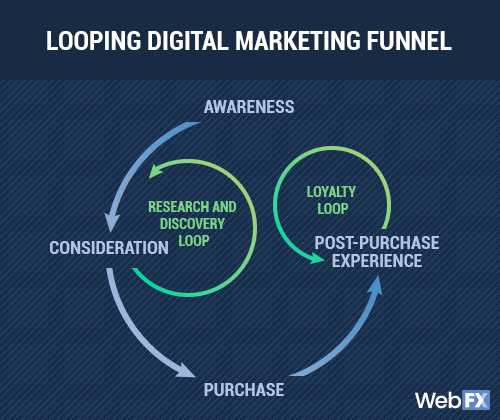
There are only six stages in this digital marketing funnel, and it is not as structured as the hourglass funnel described above. It is also more flexible. The six stages are as follows.
- Awareness of the problem
- Consideration is about finding the solution
- Research and discovery loop involves looking for solutions, and where the customer gathers information to solve the problem or need
- Purchase
- Post-purchase is where the focus is on extending the customer experience, so they come back
- Loyalty loop is where the customer builds a bond with your brand when they continue to get a good experience
Due to the flexible nature of the looping marketing funnel, any business can utilize it. It can be tailored to suit the specific needs of a business too.
3. Micro-moments Digital Marketing Funnel
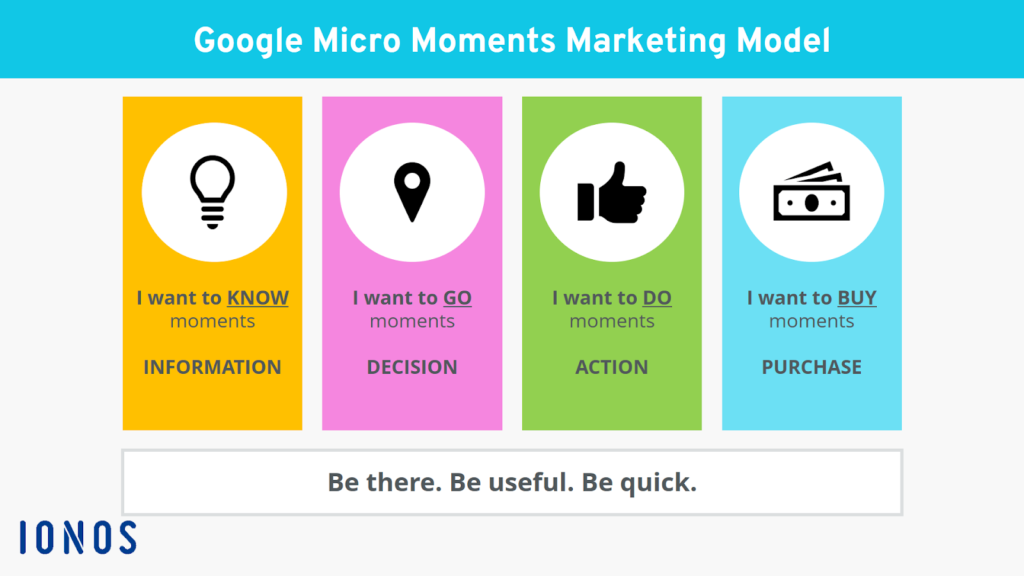
A concept developed by Google, it’s a type of marketing funnel that is based on micro-moments. It focuses on the reasons that motivate users to enter the funnel. As depicted in the graphic above, four moments comprise the micro-moments digital marketing funnel.
- Want to know moment
When customers search for specific information, they need to get their questions answered.
- What to go moment
These are the moments where customers look for specific information about somewhere they want to go. Typically, it could be a local business they are looking for.
- Want to do moment
These moments are where customers are seeking for a solution to a certain problem.
- Want to buy moment
It is where the customer is interested in buying something.
What sets it apart from the hourglass and looping digital marketing funnels is, it involves anticipating customer needs based on the moments.
Top 8 Funnel Digital Marketing Strategies you must know
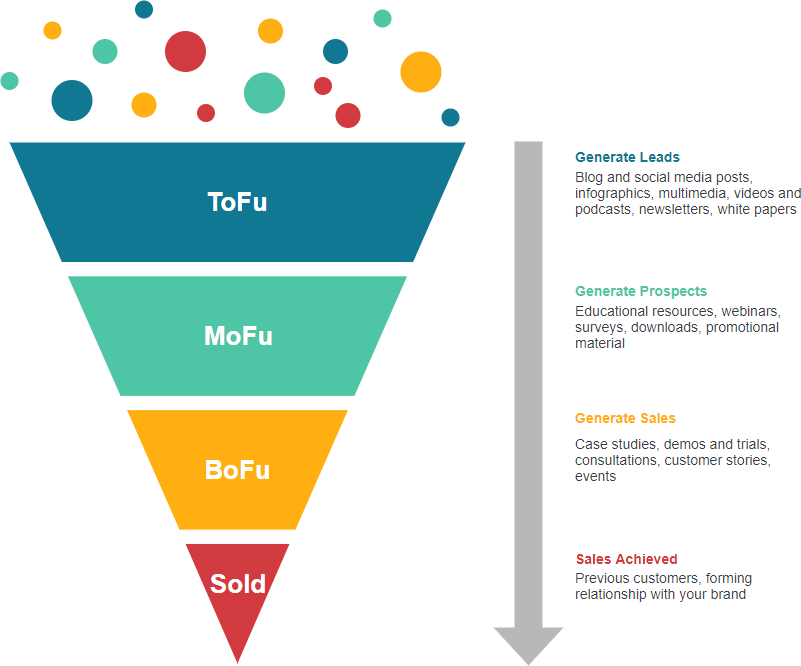
Consumers at the top of the funnel offer the highest scope of opportunities for businesses. At this point, the customers are still searching and are not yet considering or deciding to buy from your brand.
They are open to exploring their options for what they are interested in purchasing or a possible solution to a problem. There can be multiple ways to reach your customers at this stage. So businesses can employ different strategies for the same.
SEO strategies for top-of-funnel customers
SEO is a remarkable tool in improving business visibility since it enables you to reach customers organically. The user search terms can also provide insight into the stage of the customer journey.
If a potential customer is looking for general information, they are still exploring, which means providing the right information at the right time is essential.
An informative piece of content, like a blog or a guide, will drive your customer on the path of discovering your business. With SEO, your business can achieve brand building. You can become a go-to resource for customers at the early buying stage.
Content marketing strategies for top-of-funnel customers
Content marketing is critical for a modern business. Around 70 percent of users would prefer a blog to be the source of information about a company rather than an ad.
What’s more, users are more attracted to businesses that offer custom content, be it in the form of infographics or a blog post on topics of relevance. Optimizing your content with SEO is also a good idea.
With SEO-rich content, you have a higher chance of being discovered through search results. Search results on the first page have the most likelihood of being noticed. Your business will barely have any visibility and very little website traffic if it appears on the second page of the search results.
Social media marketing strategies for top-of-funnel customer
Social media sites are among the most visited sites in the world. Therefore, social media marketing is of great value in reaching top-of-the-funnel users. Building brand awareness has now become quite effective and common on social media platforms.
Figure out your target audience’s preferred social media platforms to acquaint them with your brand and show them how it matches their expectations. Influencer marketing can also be effective in promoting your brand.
It is a quick and direct way to make contact with top-of-the-funnel customers. Since influencers are already trusted, that can also benefit your brand by improving your brand’s first impression.
Video marketing strategies for top-of-funnel customer
Videos are extremely effective and popularly consumed content. You can post videos about your products and related information, promotional videos, etc.
Research shows that even watching a single video can increase brand association. Also, the likelihood of buying can increase after watching a video.
Middle of the Funnel Digital Marketing Strategies

User actions are different in the middle of a digital marketing funnel. A lot of actions take place in this stage. Some are interested in one specific product; some are looking at multiple brands.
Here are some strategies that work well at this stage in the funnel.
Email marketing: This is a proven way to reach out to your customers and communicate with them about your product. At the same time, your emailers need to have content that is of interest to your clients. Therefore, it is a good idea to include updates, offers, any other information related to your brand and relevant to the customer.
There can be several reasons why users sign up for your emailers. It is a good idea to segment the audience as per their motivations to buy your products.
SEO: It can also be useful here. However, the approach for targeting keywords is different at this stage compared to those for top-of-the-funnel customers.
Content Marketing: Here, too, the idea is to adapt the content marketing strategies to suit the middle of the funnel customers. At this stage, more comprehensive and in-depth content is required. A how-to-guide, for instance, could be a good example.
Bottom of the Funnel Digital Marketing Strategies

Customers at this stage can be the most important for some businesses. They’re ready to make a purchase or call or go to the actual location. To make sure customers at this stage take notice of the brands, many companies add paid marketing efforts to the mix. Here are a few tips on how to maximize returns at this stage.
PPC strategies for Bottom of the funnel Customers
Pay-per-click advertising helps companies attract customers who are ready to buy. So it covers the ‘want-to-buy’ micro-moment customers. Along with that, PPC can also help reach out to customers who have been researching the products they are looking for.
Upon developing a PPC campaign, you need to gauge the potential customers’ shopping potential. Your campaign budget must be within limits to suit the budgets of your target audience.
But also make sure that you are able to make returns on your investment. Another important factor to consider is your target audience’s motivation for buying. Once you understand your target audience, it can easily inform your marketing strategies.
Email marketing for bottom-of-the-funnel customers
Email marketing is a highly dependable strategy for bottom-of-the-funnel users. In fact, email marketing is more effective in generating sales as compared to other lead generation methods.
Yet another important tactic is segmenting your audience. Depending on whether your audience is ready to pre-order or has abandoned shopping carts, you can plan to send out emailers accordingly.
Understanding your audience’s intent is crucial in creating a marketing strategy. It can also help in cultivating loyalty toward your brand.
SEO strategies for bottom-of-the-funnel customers
Using SEO for bottom-of-the-funnel users by focusing on actionable words can be helpful. For instance, using the word ‘buy’ shows intent to purchase. However, it should be noted that SEO focusing on the bottom of the buying funnel is often quite competitive.
That’s why every business is ready with its website optimized with these high-value keywords. But on the other hand, if a website marketing funnel is optimized for targeting every stage of the funnel, that can help eliminate competition and improve brand visibility.
Here’s How Your Business Can Succeed With A Digital Marketing Funnel
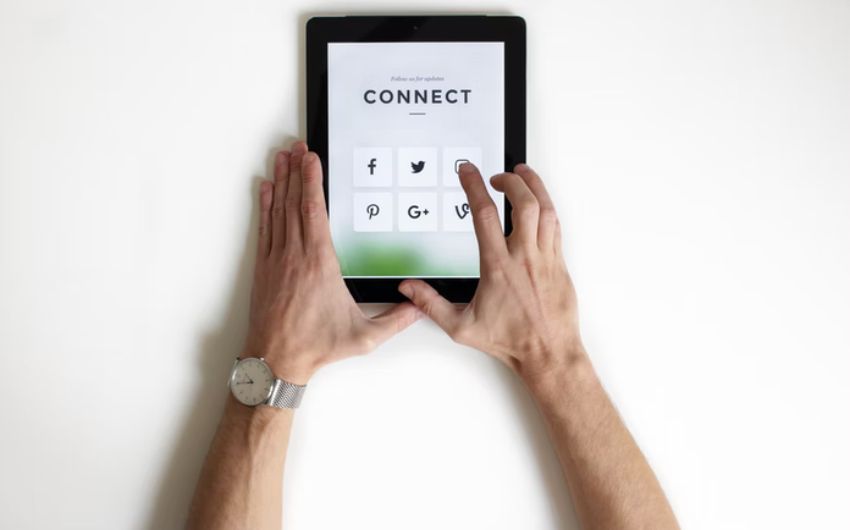
As there are different types of digital marketing funnels that you can apply to your business, the question is, how do you know which one is best suited for your business.
Moreover, how do you utilize the strategies at each stage of the funnel for achieving optimum results? While using the right funnel is great, you should also remember that there are a few strategies that you must adopt, irrespective of which funnel you choose.
1. Customer Support
Offering 24/7 assistance is a must since there are more than enough opportunities to solve customer problems in the course of the buying cycle. In addition, by being there for your customers, you assist them with their problems and build relationships with them.
It could possibly make a lasting impression and also offer the customers an opportunity to build a bond with your brand. Apart from the traditional ways of offering assistance, you can provide an online guide, FAQs, chatbots, and other such options where customers have access to assistance easily.
2. Look Beyond What The Metrics Tell You
Information is crucial and it is even more so in this age of digital marketing. Data informs you and offers insightful inputs with regards to the effectiveness of your strategy. It also helps you better understand user behavior.
However, on the other hand, if you become singularly focused on the data, that can hamper your progress. It is ideal to look beyond data in order to achieve real growth in business.
Here are a few aspects which you can pay attention to other than the metrics:
- User intent
- User interaction
- Revenue
- Gross margin
- Profit
3. Use AI and Machine Learning
In the age of digital marketing, AI and machine learning are integral parts of business growth. With the help of these tools, your team can analyze an immense amount of insights into your business.
You can develop input-driven campaigns for marketing and make improvements as per necessity at a fast pace. In addition, the technology can contribute in the following ways:
- Personalized user experience
- Insight into user intent
- Connecting and collating data related to user behavior
- Keyword research and opportunities for content generation
As a business, you can monitor your online marketing efforts with the use of third-party software. There are times when companies develop independent software for in-house use, but it may come at a higher cost.
Whichever method you decide to adopt, the utility of AI and machine learning in businesses is undeniable. Businesses are better off making use of it in advancing and achieving their goals.
4. Be Specific With The Target Audience
Narrowing your target audience is a great way to improve your digital marketing funnel. While you work toward appealing to every member of your target audience, you can also succeed by being specific and working with a niche audience.
It is possible to improve your ROIs by narrowing your target audience. And then promote customized content to customers who bring more value to your business. There are customers who may spend more and some who may spend less.
It is a good idea to identify the customers who spend more and shop more often. Then, have a strategy in place to promote your business to specifically them. They are your ideal customers.
5. Make The Most Of Your Brand Value

Businesses can ensure the success of their business by using their brand to their advantage. One way to do this is by establishing how the brand is there for the users, understanding their needs and pain points at every step of the buying funnel.
In addition, businesses can improve brand loyalty to ensure a life-long connection with the customers. Here are a few ways in which you can leverage your brand value and stand to benefit as a result of that.
- Know what your customers need
- Find out how your products or services can best serve those needs
- Determine the ways in which your company lives up to user expectations
- When users benefit and their needs are met, it is a win-win
Incorporate your findings into developing content across the various platforms promoting your brand presence.
Key Takeaways
The importance of a digital marketing funnel cannot be overstated. It is vital to understand its importance for growing your business.
The different types of digital marketing funnels adopt many ways for a business to understand how their customers interact with their content and what they need in order to convert them.
Right from the start, when someone comes to know about your business, until the time of purchase, there are opportunities to reach out to your customers at every step.
That is what the digital marketing funnel is all about. It helps businesses identify, determine, and take advantage of every opportunity to know the customer better so they can serve them better.
Digital marketing funnels are the driving force of a business. They are the most effective way to get leads and convert them into customers. As a result, they can increase sales for your business.
It starts with someone who visits your website and then follows a series of steps. These steps could include adding an item to their cart, signing up for an email list, or downloading an ebook.
There are three major types of digital marketing funnels. They include the hourglass funnel, looping funnel, and micro-moments funnel. Each have their advantages and characteristics which can benefit businesses.
Here are a few benefits of using a digital marketing funnel for your business:
- Helps build trust with potential customers
- Increases customer loyalty
- Increases conversion rates
In conclusion, a digital marketing funnel for your business is a useful tool for measuring, tracking and optimizing your marketing efforts. It also helps you identify what is working and what isn’t and offer your customers the best possible experience.
FAQs
Build a funnel for your digital marketing efforts.
– To make advertisements and content. Objective, trust-inducing material will guide the readers and encourage them to visit your website.
– Create an intriguing offer to promote your activities.
– Set up a landing page to display your offer, skills, and services.
– Create an email sequence to remind your audience of your presence and provide helpful material till they purchase.
– Tie everything together, so that leads may be sent to anyone who signs up for your offer.
Businesses may get valuable insight into their consumers’ journey with their brand by following the steps outlined in a B2B digital marketing funnel. It lays out the various marketing activities that should be carried out at multiple points during the client acquisition process.
When you have more information at your disposal, you can make more intelligent, more strategic choices. In addition, information gleaned from your client profiles may also provide light on the stages your customers go through in your sales and marketing pipeline.
Rapid Funnel Creation for Marketing and Sales
– Examine the actions of your target market
– Get the attention of the people listening to you
– Make a landing page
– Make a Drip Campaign in Email
– Maintain Contact
Related Articles
-
A PEEK INTO MARKETING AUTOMATION
One of the most talked about subject in the SEO industry is marketing automation which can be nearly defined to as a technology that is designed for marketing organizations so
-
Contractor Marketing Ideas, Strategies, and Tips for 2023
The marketing world is changing at a rapid pace. As digital marketing becomes more sophisticated, contractors need to stay updated on the latest trends and ideas. To help contractors in
-
8 Benefits Of Technical SEO For Your Website
Do you ever wonder why your website is not on the top of the SERP? Even though you might be following the SEO strategies, there might be chances that you

